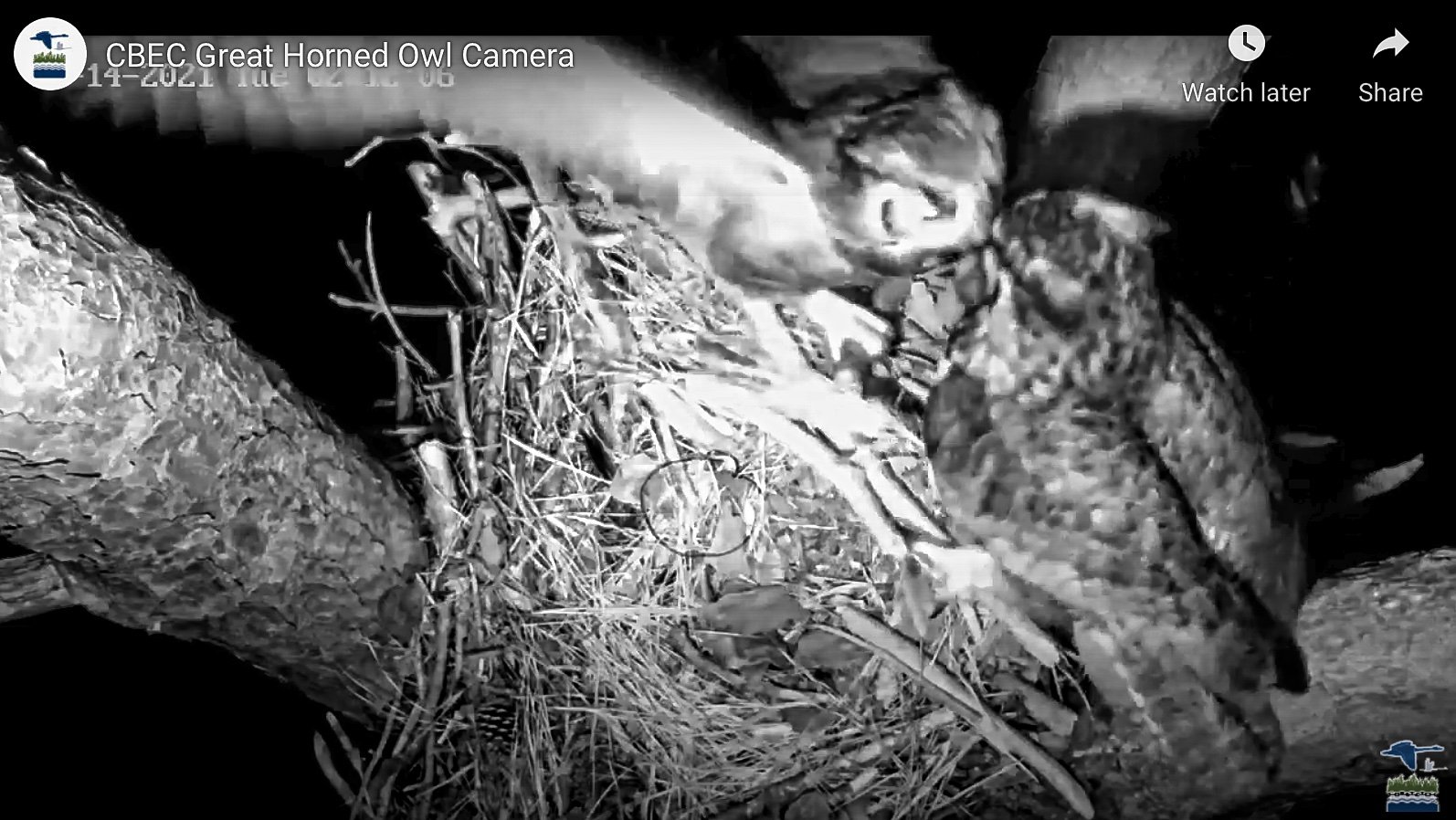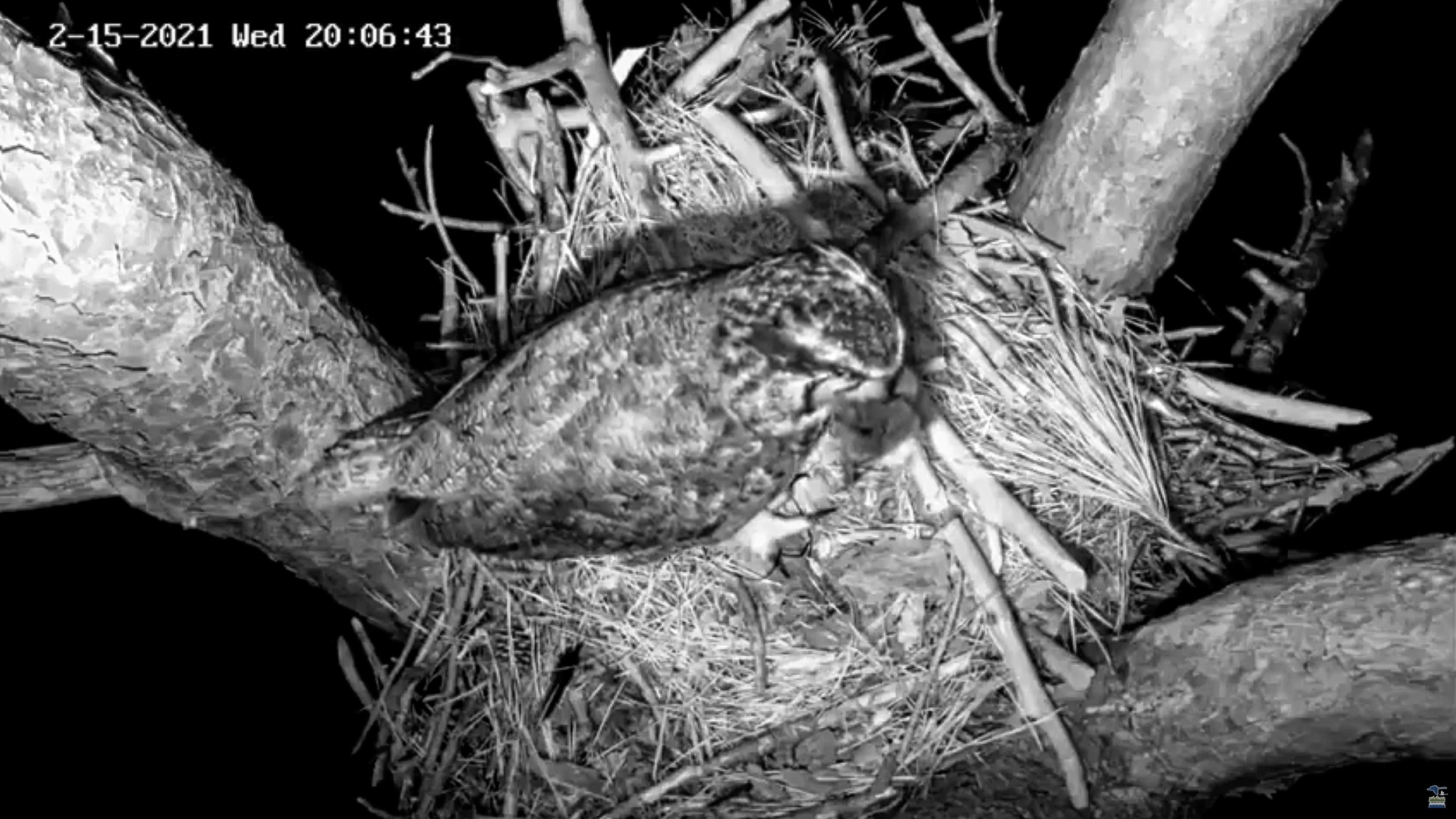Nesting Cycle
Segment 2
Pre-Nesting
“Monogamous, they stay together for life.”
“They do not build nests, they usurp other nests from crows, redtails, eagles, even squirrel nests are taken.”
“With pair bonding the male will bring food to the female. The female will give a little vocalization similar to young and when the male hears that he’ll respond by bringing food.”
“The female is the one who picks the nest.”
Food Exchange - Pair Bonding
In this video you see the male arrive at the nest with food, the female then arrives at the nest and takes the food item.
Note - to listen to the segment & view the video at the same time:
Desktop/Laptop - Start either one, then the other.
Tablet - First start the video, then play the segment.
Phone - You can not play both at the same time.
-
Next, we move into the nesting cycle with the second segment, pre-nesting.
Pre-nesting, that's an interesting and very broad spectrum subject.
It starts anywhere from September and October, where the pairs start shrinking their territory and coming in contact with each other more.
Don't confuse pre-nesting with mating.
That's a whole separate ballgame.
But pre-nesting refers to what are the birds going to do before they start the nesting cycle.
Now don't forget, their territory is large and then it shrinks as they come into the nesting mode.
The birds have to be closer together.
Starting off, they're solitary birds, monogamous, they stay with each other for life.
But, there's a big but here, when they're done tending the young from the last season, they range out because, remember the resource? They really put a heavy competition on the resource.
So they need to spread out a little bit.
So the pre-nesting really involves bringing them into the area, a smaller area, where they have regular contact.
The female is the one who picks the nest.
They do not build nests.
They usurp other nests from crows, red tails, eagles, even squirrel nests are taken.
They're the bottom of the heap.
They're not a preferred piece of real estate, but they will be utilized if that's all that's available.
Let's get back to the shrinking of the territory and now the birds are coming in contact with each other almost daily.
As I mentioned briefly, the female really selects this site.
So in this pre-nesting, they've already probably mated previously, so they know where the best nest possibilities are.
But pre-nesting is just to reacquaint them again after they've spread out the male and female throughout the large territory and it's bringing them back to the core territory.
What they do in the pre-nesting, and it's a lot of fiddling around, no mating, remember that, no mating yet, this is just, is there a nest available? Is there a change in the habitat? Has there been an increase in predators? All these things, they don't think them out, but they're very observant and they look for any changes that might affect the nesting cycle and jeopardize getting the young off the nest.
At this point, I want to interject something.
We're not fully on nesting yet, but do remember this and I will say it several times.
The more time the bird has invested in a nesting cycle, the less likely it will abandon and they want to get those babies off the nest to replace themselves.
So the pre-nesting is really a test as to whether so many things have changed or not and is it a safe environment to raise young.
Pair bonding.
In its pre-nesting stage, which I said starts sometime in September, October, they frequent the site, the core territory, almost daily.
They will call to each other and they will land on the nest periodically, observe the substrate, root around in it a little bit.
They do a lot of fiddling that's almost meaningless until they're ready to lay the eggs.
At that same time with pair bonding, the male will bring food to the female.
The female will give a little vocalization similar to young and when the male hears that, he'll respond by bringing food.
So it's really strengthening the relationship because don't forget, the male needs to feed the female while she's in incubation.
So she needs to be able to count on a reliable source of food.
So they're tightening up their relationship.
They're still distant from mating.
This is kind of setting the stage for the nesting cycle.
Referring to courtship, pair bonding.
Now remember this happens all before mating.
The owls will spend a lot of time together, roosting together, talking with each other, hooting back and forth.
And during, especially during December, that's when the vocalizations really begin to increase.
And at that time, a core territory is set.
A nest is selected.
The pair bonding is complete.
The courtship is in full throttle and mating is about to come up.
I should mention at this point, most of the birds in the mid-Atlantic region, and I'm giving a range here, lay eggs between March and somewhere early April.
That's kind of late.
Our birds in Maryland usually lay eggs end of January, beginning of February.
But if you go to references, they'll say frequently March.
What happens is after the nest is selected and prepared, and there is a little preparation.
I did mention that they do a lot of fiddling around, scraping with feet, rolling body, make a cup into the existing nest, etc.
Next comes the mating part.
These birds will mate several times in the course of a day.
But the closer to that cycle, our cycle is end of January and February, the closer to that cycle, the mating increases in frequency.
They'll sometimes mate up to 20, 30 times in an evening because to ensure that there is a proper exchange of sperm to fertilize the eggs, the mating copulation needs to occur a number of times.
After the bird is mated, that sperm will last about 30 days.
And this is because, since horned owls are top predators, if something would happen to one of the mates, there is the possibility of a continuation of the cycle, primarily because of the male, if something would happen to the male, I should specify.
The mating has occurred, and the next step we'll go into will be the egg laying.
A second reason for the longevity of the sperm cells is, remember, these birds only have one clutch, one set of babies per year.
And if after the eggs were laid, if for some reason there was a nest failure, the eggs fell through the nest or something like that, the bird, the female, does not need to mate again because those sperm cells are still stored in the body.
So immediately, re-fertilization of a new set of eggs can occur at that time.
Why only one clutch? Because the young will stay with the parents for a very long time after they fledge, learning the haunts and learning the hunting.
They learn through mimicry and association.
So there's not enough time in the course of the year to have a number of clutches, a number of sets of babies.
And as a result, this is true with most of the avian predators, they will only have one clutch because of the long-term existence with the fledglings and parents until they're ready to go totally on their own.









